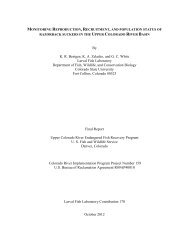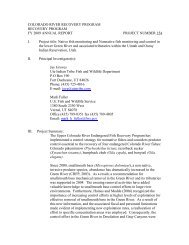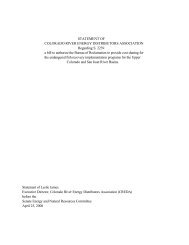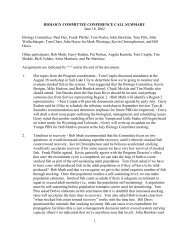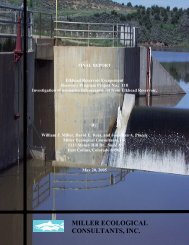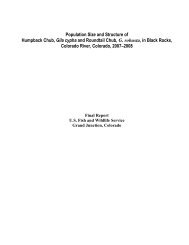riprap - Upper Colorado River Endangered Fish Recovery Program
riprap - Upper Colorado River Endangered Fish Recovery Program
riprap - Upper Colorado River Endangered Fish Recovery Program
You also want an ePaper? Increase the reach of your titles
YUMPU automatically turns print PDFs into web optimized ePapers that Google loves.
determine if it is a significant source of northern pike moving downstream into criticalhabitat. Active management of northern pike downstream of Hayden began in 2003. In2005, CDOW began undertaking work to determine sources of northern pike that maygain access to endangered fish critical habitat in the Yampa <strong>River</strong>. Prior to the 2011sampling season, the <strong>Recovery</strong> <strong>Program</strong> recommended and CDOW agreed todiscontinue the pike marking pass in the Yampa <strong>River</strong> buffer zone.Active control of smallmouth bass in a 12-mile treatment reach in Little Yampa Canyon,a 5-mile treatment reach in Lily Park, and in the lower Yampa <strong>River</strong> in Yampa Canyonbegan in 2004. The 12-mile treatment was expanded to 24 miles in 2006 in order togeographically include the targeted population. Management was also expanded in2006 to include the South Beach reach immediately upstream of the Little YampaCanyon treatment reach in order to focus control on concentration areas. In 2009,smallmouth bass management was expanded throughout critical habitat. Prior to the2011 sampling season, the <strong>Recovery</strong> <strong>Program</strong> recommended and CDOW agreed tocease translocation of adult smallmouth bass from the Yampa <strong>River</strong> into ElkheadReservoir due to concerns about the rate of escapement of translocated and residentsmallmouth bass from the reservoir and the propagule pressure and proliferativecapacity of these escapees within critical habitat.The <strong>Program</strong>’s integrated stocking plan (Nesler et al. 2003) outlines plans for stockingbonytail in the middle Green <strong>River</strong> which includes the confluence of the Yampa <strong>River</strong>.Stocking bonytail at the confluence of the Yampa and Green rivers was initiated in2000.3.3 DUCHESNE RIVER3.3.1 Importance<strong>Colorado</strong> pikeminnow and razorback sucker regularly utilize the mouth of the Duchesne<strong>River</strong> especially during spring runoff. <strong>Fish</strong>ery surveys conducted in 1993 documentedthe use of the lower 15 miles of the Duchesne <strong>River</strong> by <strong>Colorado</strong> pikeminnow andrazorback sucker. More recently, fish surveys have been conducted in the lower 33miles of the Duchesne <strong>River</strong> and have documented seasonal use by <strong>Colorado</strong>pikeminnow and razorback sucker.3.3.2 <strong>Recovery</strong> ActionsInitial flow recommendations were developed for the Duchesne <strong>River</strong> in 1995 toaddress immediate concerns of several proposed water projects being considered inthe Duchesne <strong>River</strong> basin. A follow-up study to evaluate and refine these flowrecommendations began in 1997 and was completed in 2003 (Modde and Keleher2003). A water availability study was completed that identified sources of water to meetthe flow recommendations. A coordinated reservoir operations study was completed in2004. The Duchesne Biological Opinion issued in 1998 was updated in 2005. The19




